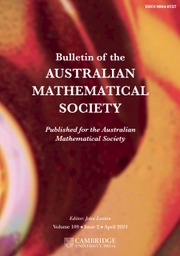Crossref Citations
This article has been cited by the following publications. This list is generated based on data provided by Crossref.
ALLU, VASUDEVARAO
and
SHAJI, AMAL
2024.
THE SHARP BOUND OF THE SECOND HANKEL DETERMINANT OF LOGARITHMIC COEFFICIENTS FOR STARLIKE AND CONVEX FUNCTIONS.
Bulletin of the Australian Mathematical Society,
p.
1.
Kumar, Sushil
Pandey, Rakesh Kumar
and
Rai, Pratima
2024.
Sharp bounds on Hankel and Hermitian–Toeplitz determinants of associated Sakaguchi functions.
Lithuanian Mathematical Journal,
Vol. 64,
Issue. 4,
p.
491.
Ali, Md Firoz
and
Nurezzaman, Md
2024.
The Second Hankel Determinant for Some Classes of Univalent Functions.
Mediterranean Journal of Mathematics,
Vol. 21,
Issue. 8,



